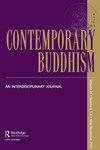Mountain Buddhism in East Asia
IF 0.1
3区 哲学
0 PHILOSOPHY
引用次数: 0
Abstract
Mountains play a central role in Buddhist cosmology and practice. Scriptural accounts of Mount Sumeru (cosmological center of the Hindu-Buddhist universe) and Vulture Peak in India (favored abode for the Buddha and a panoply of deities and disciples) clearly attest to this, as does the physical and symbolic construction of Buddhist sacred sites in mountainous locales. The varieties of Buddhist activity that developed in East Asia reflect a new valorization of mountains not found in India, however. Diverse forms of Buddhist thought and practice took root at mountain sites throughout present-day China, Korea, and Japan, flourishing in complex and fascinating ways over time through transregional and transcultural exchange—and always in relation to (and sometimes competing with) local concerns and customs. International research on Buddhist mountain spaces, places, and practices has prospered in the late 20th and early 21st centuries, with various monographs, anthologies, and essays presenting information about mountains in Buddhist discourse or Buddhist activity that takes place in mountains. Still, no single work to date investigates mountain Buddhism in East Asia in a comprehensive or comparative manner. This review introduces an eclectic mix of English-language sources, grouped thematically (although with significant overlap), that span all time periods and employ various disciplinary approaches. The slight geographical imbalance present in the list reflects the nascent state of research on Korean religions and the exceptionally well-developed body of work on mountain Buddhism in Japan, especially Shugendō, a combinatory and mountain-centric religious tradition deeply influenced by Buddhist doctrine and ritual.东亚的山地佛教
山脉在佛教的宇宙观和实践中扮演着核心角色。《圣经》中关于苏美鲁山(印度教-佛教宇宙的宇宙学中心)和印度秃鹫峰(佛祖和众多神祇和信徒的住所)的记载清楚地证明了这一点,佛教圣地在山区的实际和象征性建筑也证明了这一点。然而,在东亚发展起来的各种佛教活动反映了印度没有发现的一种新的山脉价值。不同形式的佛教思想和实践在今天的中国、韩国和日本的山区扎根,随着时间的推移,通过跨地区和跨文化的交流,以复杂而迷人的方式蓬勃发展,并且总是与当地的关注和习俗有关(有时与之竞争)。在20世纪末和21世纪初,国际上对佛教山地空间、地点和实践的研究蓬勃发展,出现了各种专著、选集和论文,展示了佛教话语或佛教活动中关于山脉的信息。然而,迄今为止,还没有一部著作以全面或比较的方式研究东亚的山地佛教。这篇综述介绍了英语资源的折衷组合,按主题分组(尽管有明显的重叠),跨越所有时期,并采用各种学科方法。名单上轻微的地域不平衡反映了对韩国宗教的研究刚刚起步,而日本对山地佛教的研究则非常发达,尤其是以山为中心的宗教传统,深受佛教教义和仪式的影响。
本文章由计算机程序翻译,如有差异,请以英文原文为准。
求助全文
约1分钟内获得全文
求助全文

 求助内容:
求助内容: 应助结果提醒方式:
应助结果提醒方式:


